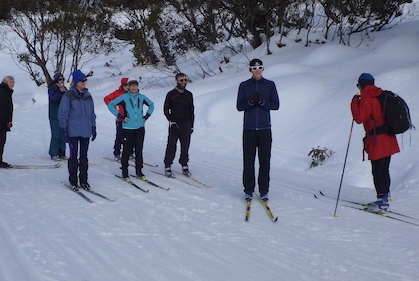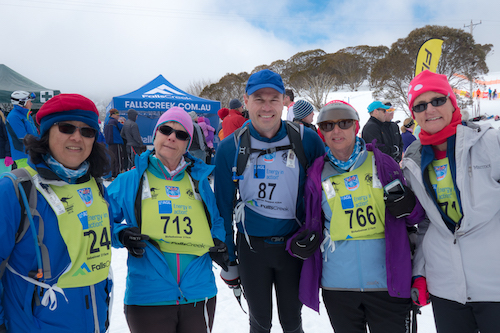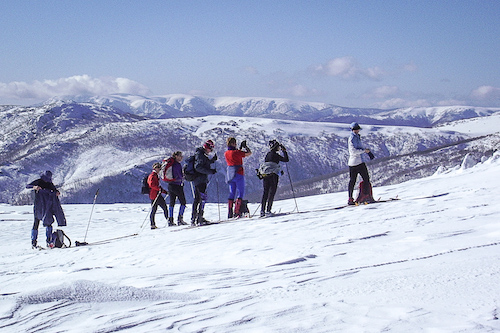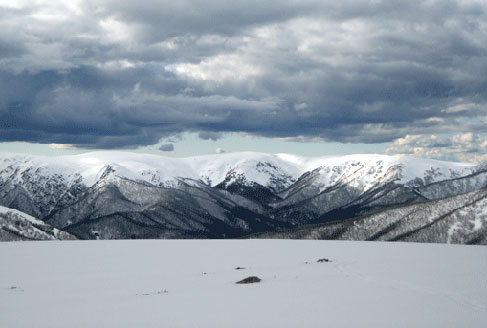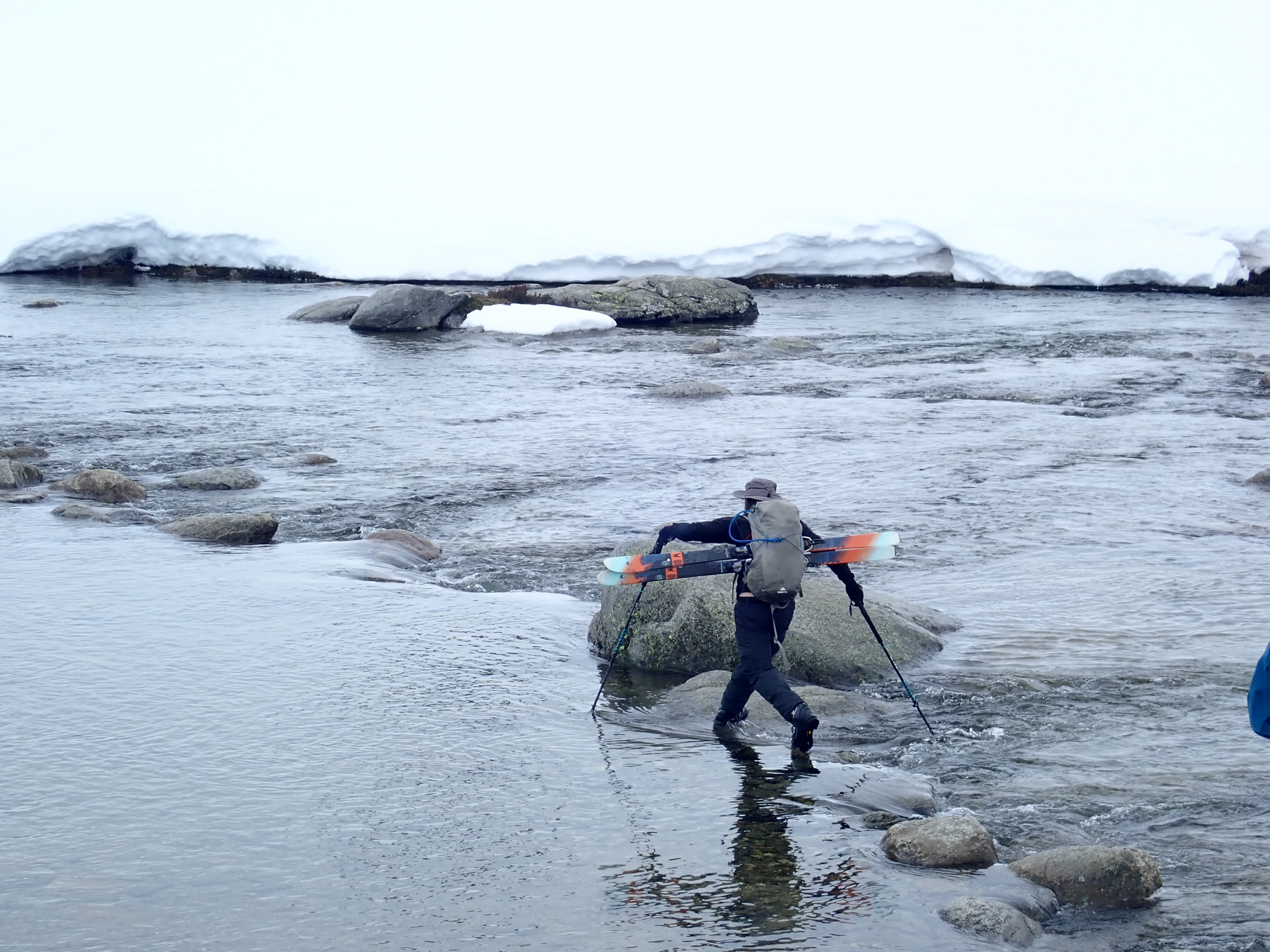A great way to keep costs down ×

Skiing in Australia is expensive. Cross country skiing is no exception, although of course, it is not as expensive as alpine skiing. Our club has decades of experience of finding and booking relatively inexpensive skiing accommodation.
Our ride sharing system helps to keep transport costs in check and our collective knowledge about ski gear can help you keep the cost of gear in check. We also have an online gear exchange where you can buy and sell gear within the club.
Snow Camping
Away from the Madding Crowd
Skiing Ability
Carrying a pack on skis will put your skills to the test. It is definitely not the time for fancy footwork and it is not an activity for a beginner skier. You don't need to be an expert for trips on the Melbourne Nordic calendar, but you do need at least one or two seasons of skiing experience. You should be at the point where you can confidently snowplow on a moderate slope and you should be confident at side-stepping or herringboning up a hill. If you are more accustomed to track skiing, don't forget that you will be on heavier skis. They may not be fast gliding, but they will be more forgiving on the downhill.
Gear
| Item | Alternatives | Comments |
|---|---|---|
|
Sleeping Bag |
Down is lightest. Synthetics perform better when wet, but are heavier (for an equivalent temperature rating). |
This is one of the two most important pieces of gear you need for a safe and comfortable trip. See next comment. |
|
Sleeping Mat |
Some people combine a short Thermarest with a full length closed cell foam mat or Ridge Rest for greater comfort where it counts most (upper body). Inflatable down pads are OK, but tend to be bulky. |
This is just as essential as a good sleeping bag. Without an effective insulating layer under your bag, you won't stay warm at night. Lack of an adequate combination of bag and mat can be a serious safety issue. If you rely on an inflatable mat, bring a repair kit. |
|
Pack |
For obvious reasons, you need to carry more gear for snow camping than for summer, so a decent sized pack is necessary. |
|
|
Skis |
Classic track skis are not adequate. They don't have enough flotation and they are not strong enough. The extra weight of a pack can break them. |
|
|
Boots |
If you don't have down boots (see below), you can wear the removable inners of a pair of plastic Telemark boots in the evenings. |
|
|
Poles |
Telescopic poles are great if you have them. |
|
|
Sunscreen (and lip balm) |
You will be out in the weather for most of the daylight hours. The higher the altitude, the worse it gets. The sun on Main Range (NSW) can be savage. |
|
|
Water Bottle |
Hydration bags can be used if they are easy to fill (eg, from a creek) Other types of water carrying bags are available. Empty wine cask bladders are OK. |
You need a good supply of water for cooking and you don't want to go off to the creek in the dark for more water in the middle of things. |
|
Head Torch |
The sun goes down pretty early in winter and early spring. You almost always end up cooking and/or eating after dark. |
|
|
Food utensils. |
Trangia type stoves usually come with plates and bowls, but you will still need a cup and cutlery. |
|
| Sunglasses | Ultra Violet light can be extreme at altitude in the snow, even on overcast days. Reflected UV from the snow, or UV entering your eyes from the side of non-wraparound sunglasses can cause snow blindness and permanent eye dammage. Protect your eyes! | |
|
Plastic Bags |
Great for keeping things dry and you'll need at least one for rubbish (cooking scraps etc.) |
|
|
Whistle |
Helps people to find you if you get lost. |
|
|
Day Pack |
Most trips involve touring from a base camp. A daypack that can be folded up very small to fit inside you pack is ideal. |
| Item | Requirements | Alternatives | Comments |
|---|---|---|---|
|
Tent |
Four Season with strong poles (preferably aluminium) and a decent sized vestibule. |
Bivvy sac (for very hardy types!) |
Most people carry 2 person tents. A lot of people like to have a 2 person tent to themselves, so they can spread their gear out, but of course this is a heavy option. |
|
Snow Pegs |
Should be at least 30cm long. Typically aluminium. |
Sand pegs are cheaper and work OK, but are bulkier to carry. |
Ordinary tent pegs don't hold in snow. Snow pegs are longer and wider. |
|
Stove |
Trangia style methylated spirit burning or MSR style Shellite burning. |
Too many types of fuel stove to list. |
Avoid butane fuelled camping stoves. They are not reliable at low temperatures. And make sure you always have some dry matches. Stashing boxes of matches in various places in your pack in case others get wet is a good strategy. |
|
Fuel bottle |
Aluminium is best. |
Bring plenty of fuel in case it is necessary to melt snow to supply water. This can be necessary if there is no open creek near the campsite. In a particularly good season, open creeks can be hard to find near some camp-sites. |
|
|
Snow Shovel |
Should be metal. |
One shovel between four is enough, but one per tent is best. Plastic shovels used for digging cars out of fresh snow are not generally effective for firm snow. |
- First Aid Kit
- Map
- Compass
- GPS Personal Locator Beacon (for alerting rescue agencies in event of emergency when travelling in isolated areas)
Clothing
| Item | Requirements | Alternatives | Comments |
|---|---|---|---|
|
Thermal Underwear |
Various types are available. |
Polypropylene has fallen out of favour. It smells bad and shrinks dramatically if you accidentally wash it in hot water. |
|
|
Waterproof Jacket |
Goretex shell type is standard. |
Other similar membrane materials. |
Jackets with padding/insulation are not ideal. They are bulky to carry. |
|
Waterproof Overpants |
Goretex shell type is standard. |
Other similar membrane materials. |
Pants that can be put on and off with ski boots on are ideal. This usually requires some kind of zip system. Downhill skiers overalls are not ideal. They are bulky to carry and often too hot. |
|
Down Jacket |
Two or three fleece layers or extra thermals. |
For wearing around the camp-site in the evenings. |
|
|
Waterproof Gloves |
Fleece gloves plus waterproof overmittens work OK. |
Keep some spare gloves dry in your pack. You will appreciate them at the camp site. |
|
|
Beanie |
Fleece |
You will really need this in the camp-site, even if the day has been warm. |
| Item | Comments |
|---|---|
|
Down Boots |
For wearing around the camp-site in the evenings. Removable inners of plastic ski boots can be used, but are not as warm. |
|
Goggles |
If you have to ski in bad weather, goggles make it much more comfortable. |
|
Fleece pants |
For wearing around the camp-site in the evenings. Alternatively put on some extra thermals. |
|
Foam Mats |
Cut up a cheap closed cell foam mat into pieces about 30cm long and bring one or two to sit (or cook) on at night. |
|
Waterproof Pack Cover |
If you can get hold of one, these covers help to keep r&*%$# and snow out of your pack when you are skiing. |
| Foam mat for tent floor | A thin (2-3mm) foam mat that covers the entire tent floor, though bulky to carry (outside the pack) provides insulation that prevents condensation forming on the cold tent floor. You keep drier and warmer while in the tent. |
What Food to Bring?
- Your fingers get cold if you have to spend a lot of time with your gloves off, so don't bring fiddly things.
- If the weather is bad, you will want to cook quickly, so don't bring things that take a long time.
- Washing pots is not so easy, so try to arrange "one pot" meals.

